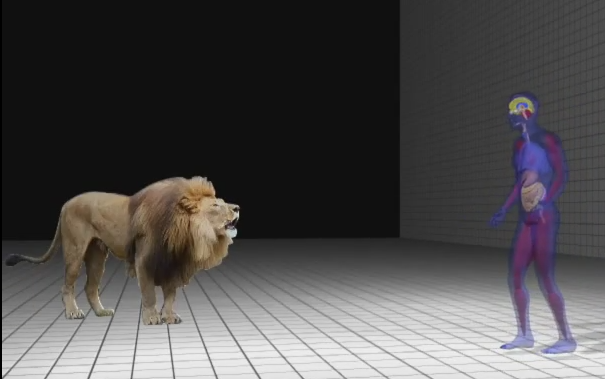In times of emergencies, the body undergoes physiological and psychological changes, which help prepare it to face the danger. The body is able to respond in an unordinary way to encounter the emergency. The sympathetic nervous system is part of the autonomic nervous system, which plays the role of controlling involuntary functions in body including response by the body to emergency situations.
Autonomic nervous system consists of processes that you don’t purposely control and is divided into sympathetic and parasympathetic nervous systems. The parasympathetic nervous system, which is also known as the rest and digest system, helps in normal autonomic functions. A person is most of times in parasympathetic nervous system.
However, when emergency and stressful situations arise, changes can occur in body to prepare you to deal with the danger or threat. In such situations, the autonomic nervous system is controlled by the sympathetic nervous system, which is also referred to as fight or flight response.
In a sympathetic nervous system, the physiological changes, which occur, are designed to give someone the ability to make through or survive emergency situations. The system gives and individual super powers that are usually described as beyond the normal capabilities of a person.
A typical example of a fight or flight response
When walking down the street, you may encounter an incident where a man suddenly steps in front of you holding a knife. The man orders you to give whatever you have with you. In such a situation, you may comply, run away, or fight the aggressor. In this situation, the body is being controlled by sympathetic nervous system.
Hormonal changes in sympathetic nervous stimulation
In the event that you encounter a dangerous situation, the body will respond by releasing norepinephrine and epinephrine hormones. These hormones cause the body to switch to a state known as adrenaline rush. This is the feeling of urgency when one is in emergency or stressful situation.
The hormones help the body be able to perform at optimal levels. In the initial activation of the sympathetic nervous system, norepinephrine is released first. It acts as preparatory hormone to get the body ready for an emergency. In case the situation turns out to be a false alarm, it can return to normal quite quickly.
In the event the emergency situation is indeed a real one, the body will need improved performed. This is the time epinephrine is released in order to augment the physiological effects. The hormones work in combination or synergically to activate the body perform optimally.
The body experiences increased respiratory rate. The blood is moved away from other areas like the digestive tract and becomes directed to limbs and muscles, which need to be energized and fueled to allow you fight or run. The pupils dilate and awareness intensifies.
The sight sharpens and the impulses quicken. The perception of pain becomes low and the immune system is mobilized. A person is now prepared both psychologically and physically to face the danger.
Function of sympathetic nervous system
Sympathetic nervous system takes care of the up and down regulation of many homeostatic mechanisms. The system regulates functions such as pupil diameter, urinary system output, and gut motility. It is best known for the control of the hormonal and neuronal response known as fight or flight.
In the fight or flight response, the preganglionic sympathetic fibers ending in adrenal medulla secrete acetylcholine. This activates the secretion of epinephrine or adrenaline to a much extent and to a lesser degree, the release of norepinephrine or noradrenaline. It is a response, which regulates the cardiovascular system and is mediated through impulses, which are transmitted through sympathetic nervous system.
A stimulation of sympathetic nervous system causes the most blood vessels to constrict particularly those in kidneys, digestive tract, and skin. This happens because alpha-1 adrenergic receptors are activated by norepinephrine that is released by post-ganglionic sympathetic neurons. The constriction of blood vessels to some of the organs is intended to give a boost to other parts and process in body.
The organs, which are not necessary to help in immediate survival, are shunted the flow of blood and there occurs an increases in flow of blood to organs that are perceived to be involved in intense activity to help an individual survive an emergency or stressful situation.
Stimulatory effects
All the essential tissues will need increased blood flow meaning that it will be stopped from reaching other areas so that it can help in this emergency situation. The blood flow to skeletal muscles will increase so as to allow an individual to escape the situation or fight off the danger.
The heart is stimulated to work faster and harder by the released of hormones norepinephrine and epinephrine. More oxygen is needed to create ATP or energy meaning the rate of breathing increases. Glycogen, which is the stored glucose, is broken down in order to provide energy.

I’m experiencing a new short difficulty When i cant appear to be competent to join the feed, I’m using search engines readers.
Er bestaan veel soorten palmen, waaronder heel bekend, de Trachycarpus fortunei.
Deze palm familie kan heel erg goed over de kou, vandaar dat
hij zodanig gewaardeerd is.
Feel free to visit my web page teeningapalmen
Где Вы ищите свежие новости?
Лично я читаю и доверяю газете https://www.ukr.net/.
Это единственный источник свежих и независимых новостей.
Рекомендую и Вам